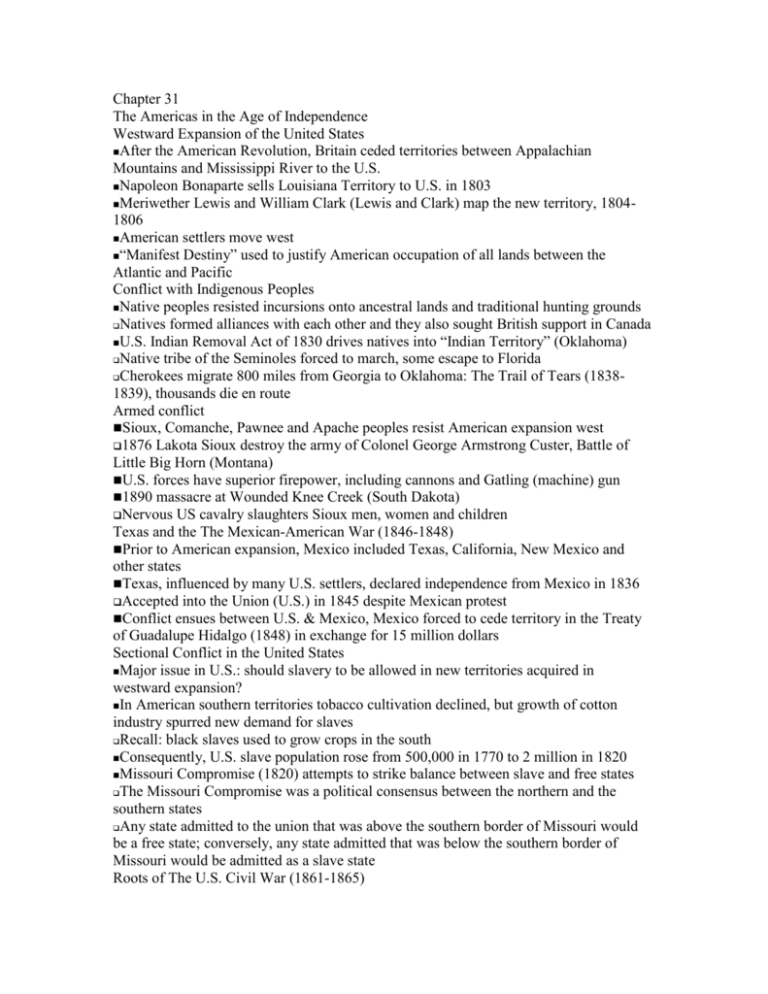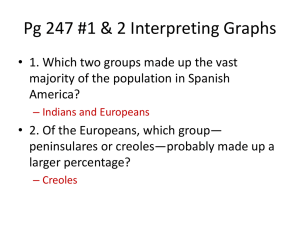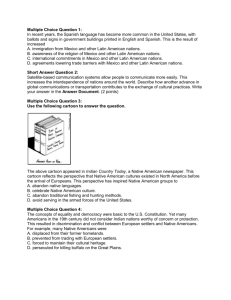chapter 31 lecture - Pasadena City College
advertisement

Chapter 31 The Americas in the Age of Independence Westward Expansion of the United States After the American Revolution, Britain ceded territories between Appalachian Mountains and Mississippi River to the U.S. Napoleon Bonaparte sells Louisiana Territory to U.S. in 1803 Meriwether Lewis and William Clark (Lewis and Clark) map the new territory, 18041806 American settlers move west “Manifest Destiny” used to justify American occupation of all lands between the Atlantic and Pacific Conflict with Indigenous Peoples Native peoples resisted incursions onto ancestral lands and traditional hunting grounds Natives formed alliances with each other and they also sought British support in Canada U.S. Indian Removal Act of 1830 drives natives into “Indian Territory” (Oklahoma) Native tribe of the Seminoles forced to march, some escape to Florida Cherokees migrate 800 miles from Georgia to Oklahoma: The Trail of Tears (18381839), thousands die en route Armed conflict Sioux, Comanche, Pawnee and Apache peoples resist American expansion west 1876 Lakota Sioux destroy the army of Colonel George Armstrong Custer, Battle of Little Big Horn (Montana) U.S. forces have superior firepower, including cannons and Gatling (machine) gun 1890 massacre at Wounded Knee Creek (South Dakota) Nervous US cavalry slaughters Sioux men, women and children Texas and the The Mexican-American War (1846-1848) Prior to American expansion, Mexico included Texas, California, New Mexico and other states Texas, influenced by many U.S. settlers, declared independence from Mexico in 1836 Accepted into the Union (U.S.) in 1845 despite Mexican protest Conflict ensues between U.S. & Mexico, Mexico forced to cede territory in the Treaty of Guadalupe Hidalgo (1848) in exchange for 15 million dollars Sectional Conflict in the United States Major issue in U.S.: should slavery to be allowed in new territories acquired in westward expansion? In American southern territories tobacco cultivation declined, but growth of cotton industry spurred new demand for slaves Recall: black slaves used to grow crops in the south Consequently, U.S. slave population rose from 500,000 in 1770 to 2 million in 1820 Missouri Compromise (1820) attempts to strike balance between slave and free states The Missouri Compromise was a political consensus between the northern and the southern states Any state admitted to the union that was above the southern border of Missouri would be a free state; conversely, any state admitted that was below the southern border of Missouri would be admitted as a slave state Roots of The U.S. Civil War (1861-1865) Abraham Lincoln elected president in 1860 Committed to anti-slavery position Lincoln wanted the end of slavery; believed that slavery was immoral 11 southern states withdraw from Union, 1860-1861 Southern states argued that abolition of slavery was a violation of states rights and that the federal government was overstepping its authority by imposing abolition legislation Southern economy dependent on cotton as cash crop; thus, the southern states depended on slave labor Northern economy based on developing industrialization and wage earners; thus, the north wanted to industrialize the south (creating unified national growth); north first had to eliminate south’s dependency on cash crop economy- possible only through the elimination of slavery The Emancipation Proclamation First two years of Civil War inconclusive Neither the North (Union) nor the South (Confederacy) gain an advantage In 1863 Lincoln signs the Emancipation Proclamation (allowing freedom for slaves who fight on the side of the Union), thus making the abolition of slavery an explicit goal of the war Battle of Gettysburg (1863) turns tide against south Eventually, the North wins after four years of bloody conflict Reasons for Union victory: advantages through industrial technology and industrial transportation systems Canada: Independence without War Recall: after the Seven Year’s War (1756-1763), England acquired Canada from France Regional divisions existed in Canadian society, but independence from England achieved without war Divisions between British and French Canadians England made concessions to the larger French population Recognition of Roman Catholic Church, French law code After 1781, British population in Ontario joined by British loyalists fleeing the U.S. after the American Revolution The British population, therefore, increases in Canada after 1781 The War of 1812 U.S. declares war on Britain over encroachments (violation) of U.S. rights during Napoleonic wars (1800-1815) U.S. decides to attach British in Canada British forces in Canada repel U.S. attacks Social tensions between French and English Canadians remains, but their alliance fighting against the U.S. in the War of 1812 served to mask or cover those tensions After the War of 1812, Canada experienced rapid industrial growth and an increased English population due to immigration Tensions increase between the growing British Canadian population and the French Canadian population British government wished to avoid a repeat of U.S. War of Independence in Canada, so the British government gradually allowed Canada home rule between 1840 and 1867 British North America Act (1867) Because British government allowed for increased autonomy, Canadian provinces were allowed to govern themselves (manage their own internal affairs) Due to the threat of U.S. expansion, England granted independence to Canada Newly-independent Canadian provinces create the British North America Act which united Quebec, Ontario, Nova Scotia and New Brunswick as Dominion of Canada Other Canadian provinces join later Provincial and federal governments with Governor-General as British representative The British still controlled Canadian foreign affairs until 1931 The Dominion controlled all domestic affairs Foreign affairs after 1931 First Canadian Prime Minister John A. Macdonald (1815-1891) purchases territory in North America and adds these and other territories to the Dominion; he also built the trans-Canada railroad Latin America Recall from Chapter 29: Independence revolutions throughout Latin America led by creoles (i.e., Simon Bolívar) Creole elites produce republics with constitutions These republics meant to benefit the creoles while keep others in society (mestizos, mulattos, indigenous, blacks) the same Thus, constitutions provide for and defend individual rights, but only/primarily for creoles Creoles, however, did not have much experience with self-rule Due to colonial legacy: the Spanish and Portuguese governments had greater administrative control over their colonies than the British Thus, political instability within the new independent republics Creoles also limit wide participation in politics A means to maintain their power and status Latin America Significant political differences divide creoles Liberals vs. Conservatives; centralists vs. federalists Republic (creole) conflict with indigenous peoples Conflict with indigenous resulted from creole attempts to extend hegemony Creole-indigenous conflict especially prevalent in Argentina and Chile Caudillos (regional military leaders) come to power in Latin American republics throughout the 19th century Caudillo formula: appeal to the masses by promising to defend their rights/interests, but once in power they ignore those promises Caudillos were more concerned with establishing order and maintaining their power than protecting the people; caudillo government, therefore, was a dictatorship Juan Manuel de Rosas, caudillo of Argentina from 1829-52, brutally maintained order Mexican Reform Attempts After U.S.-Mexico war, reform (liberal) government of Benito Juárez (1806-1872) comes to power Attempts to limit power of the military & church Creates Constitution of 1857 guaranteeing political and civil rights for Mexican men Juárez meets powerful conservative opposition, and eventually forced out of Mexico City The War of Reform (1858-1860): Mexican civil war between conservatives & liberals Juárez and the liberals eventually victorious, but civil war cripples Mexico, especially economically The French Intervention (1862-1867) Mexico suspends loan payments to foreign powers in an attempt to recover after the civil war Europeans (English, Spanish, and French) intervene to collect investments French demand more than money: empire in Mexico French, Mexican forces clash in 1862: 5 May, 1862, the battle of Puebla; Mexicans victorious, but France sends more troops France takes Mexico City and create the 2nd Mexican Empire, ruled by Emperor Maximilian of Hapsburg Juárez and Mexican liberals fight against Maximilian, eventually defeat and execute him in 1867- end of French intervention and restoration of the Mexican Republic The Mexican Revolution (1911-1920) After Juárez dies in 1872, Mexican general Porfirio Díaz comes to power in Mexico President (dictator) of Mexico for over 30 years (1876-1911) Middle-class Mexican liberals, peasants and workers join to overthrow dictator Porfirio Díaz in 1910 Beginning of the Mexican Revolution: 20 November, 1910 Revolutionary leaders Emiliano Zapata (1879-1919) and Francisco (Pancho) Villa (1878-1923) lead masses of landless peasants Despite the popularity of Zapata and Villa, they were unable to take major cities Eventually, other (liberal) revolutionary leaders enjoy greater success and create the Mexican Constitution of 1917, which addresses many of the major concerns of land redistribution, political, social, and civil rights American Economic Development California Gold Rush of 1845, also Canadian gold rushes, attract migrants to these countries Not just U.S. and Canada, but Latin America as well Others migrate to find employment/opportunities in factories, railroad construction sites, plantations, support services Migration to U.S., Canada, and Latin America Some, especially Italians, migrate and return several times Economic Expansion British capital (money) allows for vast expansion of U.S. industry Massive expansion of railroad system: 31,000 miles of rail track before 1861, almost all in eastern U.S. 200,000 miles of railroad track by 1900, coast to coast Necessitates division of U.S. into four time zones Massive expansion of U.S. economy from 1870-1900 Development of electricity infrastructure in U.S. Also development of big business (corporations and monopolies) and trade unions Canadian Prosperity British investments infuse Canada with capital Canadian policy of economic development: The National Policy The National Policy attracted migrants, promoted start-up industries, and built transportation infrastructure As a result, Canada enjoyed increased industrialization and great economic prosperity Consequently, immigration to Canada also increased U.S. also invests in Canada, owning 30% of Canadian industry by 1918 Further Canadian economic growth Latin American Dependence Most of Latin America did not experience industrialization nor the benefits of industrialization (economic prosperity) Latin American, in general, became dependent on industrial countries Due to limited foreign investment Small size of Latin American markets did not provide high demand for foreign industrial goods; thus no foreign investment Due to industrial countries’ interest in exploiting raw materials from Latin American lands Beef/meat in Argentina, for example Also, political instability and/or corruption did not allow for great or large-scale industrialization to take place in Latin America Yet, some Latin American economies rise due to significant increase in exports to industrial countries Multiculturalism in the United States The U.S. population was the most culturally diverse in the hemisphere Indigenous peoples were subject to official policy of forced assimilation Destruction of Buffalo-based economies Dawes Security Act of 1887 detract from collective tribal reservations and encourage indigenous to individually own land Native children taken from families and enrolled in white-controlled boarding schools Freed Slaves Slavery ended in 1865 after U.S. Civil War, but social discrimination remains Freed blacks discriminated against, especially in the southern states Northern armies occupy southern states, forced social program of Reconstruction (18671877) Reconstruction: reconstruction of the divided U.S. after the civil war Reconstruction stimulated industrialization in the south Reconstruction attempted to provided equality for freed slaves, but ultimately failed; nevertheless, Reconstruction provided freed slaves with significant political rights (right to vote) Violent backlash in the south after the northern armies leave Land-poor freed slaves forced to work as sharecroppers in the south A virtual return to slavery Violence and intimidation towards freed slaves continues in the south Canadian Cultural Contrasts British & French Canadians considered themselves the principal founding peoples of Canada: thus, the principal social tensions in Canada were between Anglophones and Francophones Also small populations of slaves (before abolished in 1833), freed slaves, runaways, Chinese migrants, and indigenous in Canada In the 19th century, however, tensions developed between the indigenous/métis (mixedraced) and British and French Canadians Louis Riel (1844-1885) led natives and métis (mixed-race) in rebellion in western Canada Riel rebellion was in defense of native and métis land and rights that were being violated by British and French Canadians Defeated, Riel sent into exile, Riel attempts another rebellion in 1885, executed Diversity in Latin America Latin America had a complex social structure that was based on racial background (ethnicity or skin color) Europeans, natives, African slaves, and combinations thereof Very similar to colonial social hierarchy th Increasing migration in 19 century from Asia Asian culture introduced into Latin America Some conflicts between cosmopolitan cities and backward rural areas Latin American intellectuals attempted to reform or civilize the Latin American countryside and its inhabitants








